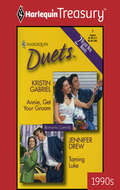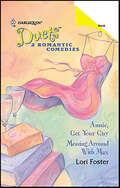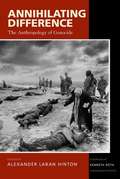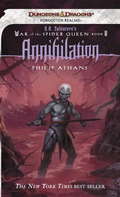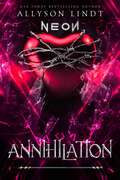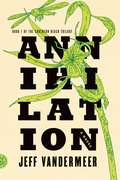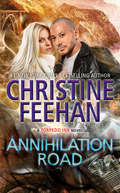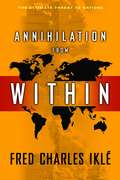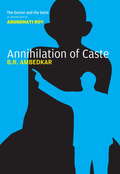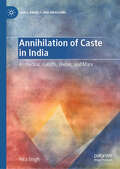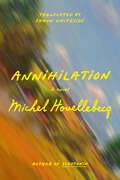- Table View
- List View
Annie, Between the States
by L. M. ElliottAnnie's home and heart are divided by the Civil War.Annie Sinclair's Virginia home is in the battle path of the Civil War. <P><P> Her brothers, Laurence and Jamie, fight to defend the South, while Annie and her mother tend to wounded soldiers. <P><P>When she develops a romantic connection with a Union Army lieutenant, Annie's view of the war broadens. <P>Then an accusation calls her loyalty into question. A nation and a heart divided force Annie to choose her own course.
Annie, Get Your Groom & Taming Luke
by Kristin Gabriel Jennifer DrewThe first novel in this duet, "Annie Get Your Groom, " concerns a single man hounded by a matchmaking father. When he makes a deal for a woman to become his fiancee-from-hell, little does he know he'll want to become her husband. In "Taming Luke, " a woman tries to transform a wild man into a CEO, but he fights her every step of the way and makes her fall in love with him.
Annie, Get Your Guy
by Lori FosterTwo stubborn hearts. One remote cabin. Endless possibilities…don't miss this fan-favorite tale from New York Times bestselling author Lori Foster! Annie Sawyers has been madly in love with Guy Donovan since they shared a few fateful kisses years ago. He's been running from her ever since, and now she's learned that he wants to propose to a woman he doesn't love, for business reasons. She's stood on the sidelines far too long. If this is the last chance she has to prove they'd be perfect for each other, then she'll go all out. Guy Donovan is horrified to hear that innocent Annie has plans to seduce someone. Especially when he puts the pieces together and realizes that his unworthy coworker is the target. It'll be a cold day in hell before he lets another man touch her—but when a car accident strands the two of them alone in a remote cabin, he's about to realize there's more to Annie than he'd ever guessed… First published in 2001
Annie, Get Your Guy and Messing Around With Max (Sawyer Family)
by Lori FosterIt's hard to get serious when your one and only won't take you seriouslyAnnie, Get Your GuyLori FosterWhat was a woman supposed to do?Guy Donovan had always treated Annie Sawyers like a little sister. But Annie already had a brother—what she wanted was a husband. Guy, to be precise! So when he announced his plans to get engaged—to the wrong woman! —Annie set out to seduce him. Which would have been a lot easier if Guy wasn't playing hard to get…Messing Around With MaxLori FosterHis love life was going to the dogs!Max Sawyers would do anything for his mangy, bad-tempered mutt, Cleo—he'd even give up his footloose lifestyle and take a wife. The trouble was, the only woman Cleo had ever taken a liking to was Maddie Montgomery. And Maddie was also the only woman on the planet who didn't want to snag Max permanently!
Annie: A True Family
by Calliope Glass<br>A Broadway classic is back on the big screen! <br>Relive all of your favorite Annie moments in this easy-to-read story, illustrated with color photos from the movie. <br>Annie is a foster kid who's had a hard knock life ever since her parents left her as a baby. She doesn't think she'll ever escape her mean foster mom, Miss Hannigan, but everything's about to change. Wanting to improve his image ahead of the election campaign, New York mayoral candidate Will Stacks takes Annie in. Stacks soon discovers that Annie's sun-will-come-out-tomorrow outlook just might be the thing he needs in his life. <br>This modern retelling stars some of Hollywood's biggest names, including Jamie Foxx (Will Stacks), Cameron Diaz (Miss Hannigan), Rose Byrne (Grace Farrell), and Academy Award nominated Quvenzhané Wallis (Annie). Director/Producer/Screenwriter Will Gluck has teamed up with producers James Lassiter, Will Smith & Jada Pinkett Smith, Shawn "JAY Z" Carter, Laurence "Jay" Brown, and Tyran "Ty Ty" Smith in this Columbia Pictures movie.
Annie: A heart-warming and gripping historical romance from the Sunday Times bestselling author
by Val WoodCan her courage lead her to a life of happiness?Annie Swinburn is harbouring a terrible secret. She has killed a man. The man was evil in every possible way, but she knows that her only fate if she stays in the slums of Hull is a hanging.And so she runs. As fast as she can, and as far as she can – up the river, along hidden paths of the Humber and into a new and familiar territory where she can start a new life.There she meets Toby Linton – a man born into a good life but now estranged from his family. He and his brother Matt earn a dangerous living as smugglers, but Annie soon realises they have more in common than she thought. And this new way of life might just offer her the chance of love, in spite of all the tragedy that has gone before…If you enjoy books by Katie Flynn and Dilly Court, you'll love Val's heartwarming stories of triumph over adversity.
Annie: A moving saga of poverty, fortitude and undying hope
by Lynda PageA young mother strives for a better tomorrow. Lynda Page's Annie is a gripping saga of a woman's struggle against poverty and hardship, to create a better life for herself and her son. Perfect for fans of Dilly Court and Cathy Sharp.When Charlie Higgins is unfairly dismissed from his job in a Leicester shoe factory his family become crippled by poverty. Refusing to surrender to her husband's misfortunes, Annie manages to keep food on the table and faith in their hearts. Until tragedy strikes again. With the threat of the workhouse looming over them, Annie and her young son Georgie seek refuge with their only relatives: the Burbages - a family they have never met and know nothing about. Adapting to farm life is a gruelling experience for Annie and Georgie, but hard work and cheerfulness earn them respect. But at the back of Annie's mind, she knows that one day she must return to Leicester to confront the memories she has left behind, and begin a new life for herself and her son... What readers are saying about Annie: 'Really enjoyed this book from beginning to end, one of those you don't want to put down. Shed a few tears along the way, but a lovely ending ''Fantastic book. Could not put it down. Just another enthralling book by a fantastic author. Would recommend this book to everyone'
Annie: A moving saga of poverty, fortitude and undying hope
by Lynda PageA young mother strives for a better tomorrow. Lynda Page's Annie is a gripping saga of a woman's struggle against poverty and hardship, to create a better life for herself and her son. Perfect for fans of Dilly Court and Cathy Sharp.When Charlie Higgins is unfairly dismissed from his job in a Leicester shoe factory his family become crippled by poverty. Refusing to surrender to her husband's misfortunes, Annie manages to keep food on the table and faith in their hearts. Until tragedy strikes again. With the threat of the workhouse looming over them, Annie and her young son Georgie seek refuge with their only relatives: the Burbages - a family they have never met and know nothing about. Adapting to farm life is a gruelling experience for Annie and Georgie, but hard work and cheerfulness earn them respect. But at the back of Annie's mind, she knows that one day she must return to Leicester to confront the memories she has left behind, and begin a new life for herself and her son...What readers are saying about Annie: 'Really enjoyed this book from beginning to end, one of those you don't want to put down. Shed a few tears along the way, but a lovely ending ''Fantastic book. Could not put it down. Just another enthralling book by a fantastic author. Would recommend this book to everyone'
Annie: Sandy's Story
by Ashley FedorInspired by the hit Broadway musical, AnnieWe all know the story of Little Orphan Annie, who is down on her luck during the Depression until she finds her beloved dog Sandy and her benevolent benefactor Daddy Warbucks. <P><P>Now the story is told for a younger audience through the eyes of Sandy, providing another perspective and a deeper look into the life of the famous canine character. After being abandoned by his own family, Sandy roams the streets, living his own hard-knock life, until he finds one irrepressible little redhead who will change his life forever. Includes black-and-white illustrations.
Annie: The Junior Novel
by Lexi RyalsA Broadway classic is back on the big screen December 19, 2014! Relive all of your favorite Annie moments in this movie novel featuring eight-pages of color photos. Annie is a foster kid who's had a hard knock life ever since her parents left her as a baby. She doesn't think she'll ever escape her mean foster mom, Miss Hannigan, but everything's about to change. Wanting to improve his image ahead of the election campaign, New York mayoral candidate Will Stacks takes Annie in. Stacks soon discovers that Annie's sun-will-come-out-tomorrow outlook just might be the thing he needs in his life. This modern retelling stars some of Hollywood's biggest names, including Jamie Foxx (Will Stacks), Cameron Diaz (Miss Hannigan), Rose Byrne (Grace Farrell), and Academy Award nominated Quvenzhané Wallis (Annie). Director/Producer/Screenwriter Will Gluck has teamed up with producers James Lassiter, Will Smith & Jada Pinkett Smith, Shawn "JAY Z" Carter, Laurence "Jay" Brown, and Tyran "Ty Ty" Smith in this heart-warming Columbia Pictures film.
Annie: The Mysterious Morgan Horse (Morgan Horse Series #5)
by Ellen F. FeldAnnie introduces a new horse to the award-winning Morgan Horse series. Uncertain of the mare's origin, Chauncy decides to bring Annie home to Gallant Morgans, but he makes it clear she can only stay if he can locate her registration papers. When Heather discovers Annie's true identity, she is afraid to tell Chauncy, knowing the horse may be returned to a cruel trainer. Heather hides the truth from her friend and soon events spiral out of control.
Annihilating Difference: The Anthropology of Genocide
by Alexander Laban HintonThis collection of original essays on genocide explores a wide range of cases, including Nazi Germany, Cambodia, Guatemala, Rwanda, and Bosnia.
Annihilation
by Philip AthansThe New York Times best-seller, now in paperback! This paperback edition of the New York Times best-selling title expands the civil upheaval among the drow, one of the most popular races in the Forgotten Realms setting. Best-selling author R.A. Salvatore wrote the prologue to Annihilation and continues to consult on the series, lending his expertise as the author who brought drow society to the forefront of the Forgotten Realms setting.From the Paperback edition.
Annihilation (Forgotten Realms: War of the Spider Queen #5)
by Philip AthansThis paperback edition of the New York Times best-selling title expands the civil upheaval among the drow, one of the most popular races in the Forgotten Realms setting. Best-selling author R.A. Salvatore wrote the prologue to Annihilation and continues to consult on the series, lending his expertise as the author who brought drow society to the forefront of the Forgotten Realms setting.
Annihilation (NEON #4)
by Allyson LindtDahlia I’ve been brainwashed. Manipulated. Lied to. Hunted.I’m still here. Fighting and stronger than ever, with the people I love by my side.But if we don’t put an end to the threat, if we don’t cut off every head of the hydra that calls itself TOM, and ensure none grow back, we’ll never be safe.The biggest problem? TOM feels the same way about us, and if they find me first, they’ll ensure none of us survive.Author's Note: This series will give you multiple happily ever afters, for multiple MMF polyamorous triads… But getting there will be one hell of an angst-filled ride.
Annihilation (Southern Reach #1)
by Jeff VandermeerArea X has been cut off from the rest of the continent for decades. Nature has reclaimed the last vestiges of human civilization. The first expedition returned with reports of a pristine, Edenic landscape; the second expedition ended in mass suicide, the third expedition in a hail of gunfire as its members turned on one another. The members of the eleventh expedition returned as shadows of their former selves, and within weeks, all had died of cancer. In Annihilation, the first volume of Jeff VanderMeer's Southern Reach trilogy, we join the twelfth expedition.<P><P> The group is made up of four women: an anthropologist; a surveyor; a psychologist, the de facto leader; and our narrator, a biologist. Their mission is to map the terrain, record all observations of their surroundings and of one anotioner, and, above all, avoid being contaminated by Area X itself.<P> They arrive expecting the unexpected, and Area X delivers -- they discover a massive topographic anomaly and life forms that surpass understanding -- but it's the surprises that came across the border with them and the secrets the expedition members are keeping from one another that change everything.<P> Nebula Award winner.
Annihilation Factor
by Barrington J. BayleyFrom the Garlowe Clusters in the north to the Veils of Darkness in the south, the Star Kingdom sprawled over roughly a fifth of the galaxy. So huge was this realm that those who tussled for power over it seemed unable to appreciate that it faced annihilation by the Patch, a roving region of peculiar pseudo-energy a light-year across which drained the life-force from any living thing it encountered.The Patch had moved into the Kingdom and was systematically feeding on system after system. Cynically unperturbed by the appalling loss of life, the royal houses merely tried to involve the Patch in their machinations, to the extent that civil war broke out all over again. But in the event, the Patch was to provide the crucial factor in the struggle for absolute power. The Annihilation Factor!
Annihilation Factor
by Barrington J. BayleyFrom the Garlowe Clusters in the north to the Veils of Darkness in the south, the Star Kingdom sprawled over roughly a fifth of the galaxy. So huge was this realm that those who tussled for power over it seemed unable to appreciate that it faced annihilation by the Patch, a roving region of peculiar pseudo-energy a light-year across which drained the life-force from any living thing it encountered. The Patch had moved into the Kingdom and was systematically feeding on system after system. Cynically unperturbed by the appalling loss of life, the royal houses merely tried to involve the Patch in their machinations, to the extent that civil war broke out all over again. But in the event, the Patch was to provide the crucial factor in the struggle for absolute power. The Annihilation Factor!
Annihilation Road (Torpedo Ink #6)
by Christine FeehanRefuel your passion with a new installment of the Torpedo Ink series by #1 New York Times bestselling author Christine Feehan.Savin 'Savage' Pajari is convinced he's not worth a damn thing. Unlike his brothers, he's a killer - a man no woman could truly love. So, when a stranger risks her own life protecting his, he can't believe it. If he had any kind of sense, he'd leave her alone, but Savage can't get the smart-mouthed woman who saved his life out of his head. With one kiss, he's lost. Seychelle Dubois has spent her entire life not feeling much of anything, until Savage comes along and sets her whole body on fire. Kissing him had been a mistake; letting him get close would be a catastrophe. He's the most beautiful - and damaged - man she's ever met, yet somehow the most irresistible. Seychelle knows so little about Savage or the dangerous world of Torpedo Ink, but his darkness draws her like a moth to a flame. Loving him could mean losing herself completely to his needs - needs she doesn't understand but is eager to learn. But what Savage teaches her could destroy her.Find out why readers are OBSESSED with Christine Feehan 'The queen of paranormal romance' USA Today 'After Bram Stoker, Anne Rice and Joss Whedon, Christine Feehan is the person most credited with popularizing the neck gripper' Time 'Feehan has a knack for bringing vampiric Carpathians to vivid, virile life in her Dark Carpathian novels' Publishers Weekly 'The erotic, gripping series that's defined an entire genre! Must reading that always satisfies!' J.R. Ward
Annihilation Road (Torpedo Ink #6)
by Christine FeehanAll paths lead to destruction in the new Torpedo Ink novel from #1 New York Times bestselling author Christine Feehan.Savin &“Savage&” Pajari is convinced he&’s not worth a damn thing. He&’s not like his brothers. He&’s a sadistic monster, a killer—a man no woman could truly love. So it completely throws him when a stranger risks her life for his, pushing him out of the way and taking the hit that would have sent him six feet under. If he had any kind of sense, he&’d leave her alone, but Savage can&’t get the woman with a smart mouth and no sense of self-preservation out of his head. With one kiss, he&’s lost.Seychelle Dubois has spent her entire life not feeling much of anything, until Savage comes along and sets her whole body on fire. Kissing him was a mistake. Letting him get close would be a catastrophe. He&’s the most beautiful—and damaged—man she&’s ever met. He has a way of getting under her skin, and what he&’s offering is too tempting to resist.Seychelle knows so little about Savage or the dangerous world of Torpedo Ink, but his darkness draws her like a moth to a flame. Loving him could mean losing herself completely to his needs—needs she doesn&’t understand but is eager to learn. But what Savage teaches her could destroy her.
Annihilation and Utopia (Routledge Library Editions: Political Science #8)
by Errol E. HarrisOriginally published in 1966. The main purpose of this book is not philosophical speculation, but to draw the obvious conclusions from political and historical facts about the prospects and methods of human political survival. The central theme is developed in the context of problems which cause most anxiety today: the mounting arms race, the unstable balance of power, the rapid growth of population, racial conflicts and ideological incompatibilities.
Annihilation from Within: The Ultimate Threat to Nations
by Fred Charles IkléIn this eloquent and impassioned book, defense expert Fred Iklé predicts a revolution in national security that few strategists have grasped; fewer still are mindful of its historic roots. We are preoccupied with suicide bombers, jihadist terrorists, and rogue nations producing nuclear weapons, but these menaces are merely distant thunder that foretells the gathering storm. It is the dark side of technological progress that explains this emerging crisis. Globalization guarantees the spread of new technologies, whether beneficial or destructive, and this proliferation reaches beyond North Korea, Iran, and other rogue states. <P><P>Our greatest threat is a cunning tyrant gaining possession of a few weapons of mass destruction. His purpose would not be to destroy landmarks, highjack airplanes, or attack railroad stations. He would annihilate a nation's government from within and assume dictatorial power. The twentieth century offers vivid examples of tyrants who have exploited major national disasters by rallying violent followers and intimidating an entire nation. To explain how we have become so vulnerable, Iklé turns to history. Some 250 years ago, science was freed from political and religious constraints, causing a cultural split in which one part of our culture remained animated by religion and politics while the other became guided by science. Since then, technological progress and the evolving political order march to different drummers. Science advances at an accelerating pace while religion and politics move along a zigzag course. This divergence will widen and endanger the survival of all nations.Drawing on his experience as a Washington insider, Iklé outlines practical measures that could readily be implemented to help us avert the worst disaster.
Annihilation of Caste
by Arundhati Roy B. R. Ambedkar S. Anand"What the Communist Manifesto is to the capitalist world, Annihilation of Caste is to India." --Anand Teltumbde, author of The Persistence of Caste B.R. Ambedkar's Annihilation of Caste is one of the most important, yet neglected, works of political writing from India. Written in 1936, it is an audacious denunciation of Hinduism and its caste system. Ambedkar - a figure like W.E.B. Du Bois - offers a scholarly critique of Hindu scriptures, scriptures that sanction a rigidly hierarchical and iniquitous social system. The world's best-known Hindu, Mahatma Gandhi, responded publicly to the provocation. The hatchet was never buried. Arundhati Roy introduces this extensively annotated edition of Annihilation of Caste in "The Doctor and the Saint," examining the persistence of caste in modern India, and how the conflict between Ambedkar and Gandhi continues to resonate. Roy takes us to the beginning of Gandhi's political career in South Africa, where his views on race, caste and imperialism were shaped. She tracks Ambedkar's emergence as a major political figure in the national movement, and shows how his scholarship and intelligence illuminated a political struggle beset by sectarianism and obscurantism. Roy breathes new life into Ambedkar's anti-caste utopia, and says that without a Dalit revolution, India will continue to be hobbled by systemic inequality.From the Hardcover edition.
Annihilation of Caste in India: Ambedkar, Gandhi, Weber, and Marx (Marx, Engels, and Marxisms)
by Hira SinghThis book offers a critical re-examination of the relationship between caste and class. Singh demystifies caste based on a comparative analysis between a Weberian and Marxian understanding of power. He rejects Max Weber’s account of caste as rooted in culture which Weber saw as analytically distinct from the economic and political power. In contrast, Singh offers a Marxist analysis of caste as a matter of land (means of production) and labor (social relations of production). Extending his critique of the cultural understanding of caste, Singh examines one of the most prominent accounts of caste as a religious phenomenon specific to Hinduism. The book aims to show the intrinsic interconnectedness of class and caste.
Annihilation: A Novel
by Michel HouellebecqMichel Houellebecq’s international bestseller— a thrilling, ambitious, and unexpectedly tender chronicle of modern existence.It is 2027. France is in a state of economic decline and moral decay.As the country plunges into a contentious presidential race, the government falls victim to a series of mysterious and unsettling cyberattacks in which videos of brutal decapitations and skillfully crafted deepfakes proliferate on the web.Paul Raison’s own troubles are bound up with those of the country. He is an adviser to the finance minister; his wife, Prudence, is a Treasury official; and his father, Édouard, now retired, spent his career in the security services. Paul, badly overworked, is facing the threat of separation from his wife. When his father suddenly suffers a stroke, Paul must depart Paris for his provincial hometown, where he and his siblings now have the opportunity to repair their strained relationships with Édouard as they determine to free him from the decrepit public nursing home where he is wasting away.Michel Houellebecq’s Annihilation reveals a new dimension of his oeuvre, adding compassion and tenderness to the irony and cutting insight that brought him international fame. Here, we see France’s most celebrated novelist taking stock of his country on the eve of great change—asking how, and whether, a society and its people can change course.

